Superpixel-Based Shallow Convolutional Neural Network (SSCNN) for Scanned Topographic Map Segmentation
Abstract
1. Introduction
1.1. Background and Challenges
1.2. Related Work
1.3. Contributions
2. Materials and Methods
2.1. Advanced Guided Watershed Transform
2.2. Superpixel Unification
2.3. Shallow Convolutional Neural Network
2.4. Parameters
2.5. Procedures
2.6. Datasets
3. Results
3.1. Advanced Guided Watershed Transformation
3.2. Shallow CNN Segmentation
4. Discussion
4.1. Advanced Guided Watershed Transformation
4.2. Segmentation
5. Conclusions
Supplementary Materials
Author Contributions
Funding
Acknowledgments
Conflicts of Interest
Appendix A
| 1 Layer | 2 Layers | 3 Layers | 4 Layers | 5 Layers | 6 Layers | 7 Layers | |
|---|---|---|---|---|---|---|---|
| F1 Measure | 0.725 (0.113) | 0.726 (0.153) | 0.704 (0.184) | 0.701 (0.173) | 0.682 (0.192) | 0.708 (0.165) | 0.660 (0.230) |
| Precision | 0.734 (0.171) | 0.760 (0.194) | 0.731 (0.231) | 0.717 (0.219) | 0.703 (0.237) | 0.736 (0.209) | 0.692 (0.268) |
| Recall | 0.758 (0.144) | 0.748 (0.168) | 0.743 (0.169) | 0.746 (0.166) | 0.725 (0.199) | 0.740 (0.176) | 0.708 (0.226) |
References
- Kienast, F. Analysis of historic landscape patterns with a Geographical Information System—A methodological outline. Landsc. Ecol. 1993, 8, 103–118. [Google Scholar] [CrossRef]
- Petit, C.C.; Lambin, E.F. Impact of data integration technique on historical land-use/land-cover change: Comparing historical maps with remote sensing data in the Belgian Ardennes. Landsc. Ecol. 2002, 17, 117–132. [Google Scholar] [CrossRef]
- Jacek, K.; Christine, E.; Mateusz, T. Forest cover changes in the northern Carpathians in the 20th century: A slow transition. J. Land Use Sci. 2007, 2, 127–146. [Google Scholar]
- Dietzel, C.; Herold, M.; Hemphill, J.J.; Clarke, K.C. Spatio-temporal dynamics in California’s Central Valley: Empirical links to urban theory. Int. J. Geogr. Inf. Sci. 2005, 19, 175–195. [Google Scholar] [CrossRef]
- Allord, G.J.; Walter, J.L.; Fishburn, K.A.; Shea, G.A. Specification for the US Geological Survey Historical Topographic Map Collection. Techniques and Methods 11–B6: US Geological Survey 2014. Available online: https://pubs.usgs.gov/tm/11b6/pdf/tm11-b6.pdf (accessed on 9 October 2019).
- Chiang, Y.Y.; Leyk, S.; Knoblock, C.A. A survey of digital map processing techniques. ACM Comput. Surv. 2014, 47, 1–44. [Google Scholar] [CrossRef]
- Liu, T.; Miao, Q.; Xu, P.; Song, J.; Quan, Y. Color topographical map segmentation algorithm based on linear element features. Multimed. Tools Appl. 2016, 75, 5417–5438. [Google Scholar] [CrossRef]
- Liu, T.; Miao, Q.; Xu, P.; Tong, Y.; Song, J.; Xia, G.; Yang, Y.; Zhai, X. A contour-line color layer separation algorithm based on fuzzy clustering and region growing. Comput. Geosci. 2016, 88, 41–53. [Google Scholar] [CrossRef]
- Liu, T.; Miao, Q.; Tian, K.; Song, J.; Yang, Y.; Qi, Y. SCTMS: Superpixel based color topographic map segmentation method. J. Vis. Commun. Image R 2016, 35, 78–90. [Google Scholar] [CrossRef]
- Miao, Q.; Xu, P.; Liu, T.; Yang, Y.; Zhang, J.; Li, W. Linear feature separation from topographic maps using energy density and the shear transform. IEEE Trans. Image Process. 2013, 22, 1548–1558. [Google Scholar] [CrossRef]
- Miao, Q.; Xu, P.; Liu, T.; Song, J.; Chen, X. A novel fast image segmentation algorithm for large topographic maps. Neurocomputing 2015, 168, 808–822. [Google Scholar] [CrossRef]
- Leyk, S.; Boesch, R. Colors of the past: Color image segmentation in historical topographic maps based on homogeneity. Geoinformatica 2010, 14, 1–21. [Google Scholar] [CrossRef]
- Khotanzad, A.; Zink, E. Contour line and geographic feature extraction from USGS color topographical paper maps. IEEE Trans. Pattern Anal. 2003, 25, 18–31. [Google Scholar] [CrossRef]
- Miao, Q.; Liu, T.; Song, J.; Gong, M.; Yang, Y. Guided superpixel method for topographic map processing. IEEE Trans. Geosci. Remote Sens. 2016, 54, 6265–6279. [Google Scholar] [CrossRef]
- Miao, Q.; Xu, P.; Li, X.; Song, J.; Li, W.; Yang, Y. The recognition of the point symbols in the scanned topographic maps. IEEE Trans. Image Process. 2017, 26, 2751–2766. [Google Scholar] [CrossRef] [PubMed]
- Mello, C.A.B.; Costa, D.C.; Dos Santos, T.J. Automatic image segmentation of old topographic maps and floor plans. In Proceedings of the IEEE International Conference on Systems, Man, and Cybernetics, Seoul, Korea, 14 October 2012; pp. 132–137. [Google Scholar]
- Dhar, D.B.; Chanda, B. Extraction and recognition of geographical features from paper maps. Doc. Anal. Recognit. 2006, 8, 232–245. [Google Scholar] [CrossRef]
- Cordeiro, A.; Pina, P. Colour map object separation. In Proceedings of the ISPRS Mid-Term Symposium, Enschede, The Netherlands, 8–11 May 2006; pp. 243–247. [Google Scholar]
- Ostafin, K.; Iwanowski, M.; Kozak, J.; Cacko, A.; Gimmi, U.; Kaim, D.; Psomas, A.; Ginzler, C.; Ostapowicz, K. Forest cover mask from historical topographic maps based on image processing. Geosci. Data J. 2017, 1, 29–39. [Google Scholar] [CrossRef]
- Zheng, H. Research and implementation of automatic color segmentation algorithm for scanned color maps. J. Comput. Aided Des. Comput. Graph. 2003, 15, 29–33. [Google Scholar]
- Salvatore, S.; Guitton, P. Contour line recognition from scanned topographic maps. In Proceedings of the WSCG, Plzen, Czech Replublic, 2–4 February 2003; pp. 419–426. [Google Scholar]
- Xin, D.; Zhou, X.; Zheng, H. Contour line extraction from paper-based topographic maps. J. Inf. Comput. Sci. 2006, 1, 275–283. [Google Scholar]
- Lu, Z.; Fu, Z.; Xiang, T.; Han, P.; Wang, L.; Gao, X. Learning from weak and noisy labels for semantic segmentation. IEEE Trans. Pattern Anal. 2017, 39, 486–500. [Google Scholar] [CrossRef]
- Li, K.; Zhu, Y.; Yang, J.; Jiang, J. Video super-resolution using an adaptive superpixel-guided auto-regressive model. Pattern Recognit. 2016, 51, 59–71. [Google Scholar] [CrossRef]
- Yang, F.; Lu, H.; Yang, M.H. Robust superpixel tracking. IEEE Trans. Image Process. 2014, 23, 1639–1651. [Google Scholar] [CrossRef] [PubMed]
- Liu, Z.; Zhang, X.; Luo, S.; Meur, O.L. Superpixel-Based Spatiotemporal Saliency Detection. IEEE Trans. Circ. Syst. Vid 2014, 24, 1522–1540. [Google Scholar] [CrossRef]
- Achanta, R.; Shaji, A.; Smith, K.; Lucchi, A.; Fua, P.; Süsstrunk, S. SLIC superpixels compared to state-of-the-art superpixel methods. IEEE Trans. Pattern Anal. 2012, 34, 2274–2282. [Google Scholar] [CrossRef]
- Shi, J.; Malik, J. Normalized cuts and image segmentation. IEEE Trans. Pattern Anal. 2020, 22, 888–905. [Google Scholar] [CrossRef]
- Felzenszwalb, P.F.; Huttenlocher, D.P. Efficient graph-based image segmentation. Int. J. Comput. Vis. 2004, 59, 167–181. [Google Scholar] [CrossRef]
- Levinshtein, A.; Stere, A.; Kutulakos, K.N.; Fleet, D.J.; Dickinson, S.J.; Siddiqi, K. Turbopixels: Fast superpixels using geometric flows. IEEE Trans. Pattern Anal. 2009, 31, 2290–2297. [Google Scholar] [CrossRef] [PubMed]
- Vincent, L.; Soille, P. Watersheds in digital spaces: An efficient algorithm based on immersion simulations. IEEE Trans. Pattern Anal. 1991, 13, 583–598. [Google Scholar] [CrossRef]
- Varun, J.; Sun, D.; Liu, M.; Yang, M.H.; Kautz, J. Superpixel sampling networks. In Proceedings of the European Conference on Computer Vision, Munich, Germany, 8–14 September 2018; pp. 352–368. [Google Scholar]
- Suzuki, T. Superpixel Segmentation Via Convolutional Neural Networks with Regularized Information Maximization. In Proceedings of the IEEE International Conference on Acoustics, Speech and Signal Processing, Barcelona, Spain, 4–8 May 2020; pp. 2573–2577. [Google Scholar]
- Csillik, O. Fast segmentation and classification of very high resolution remote sensing data using slic superpixels. Remote Sens. 2017, 9, 243. [Google Scholar] [CrossRef]
- Giordano, D.; Murabito, F.; Palazzo, S.; Spampinato, C. Superpixel-based video object segmentation using perceptual organization and location prior. In Proceedings of the IEEE Conference on Computer Vision and Pattern Recognition, Boston, MA, USA, 7–12 June 2015; pp. 4814–4822. [Google Scholar]
- Long, J.; Shelhamer, E.; Darrell, T. Fully convolutional networks for semantic segmentation. IEEE Trans. Pattern Anal. 2017, 39, 640–651. [Google Scholar] [CrossRef]
- Badrinarayanan, V.; Kendall, A.; Cipolla, R. SegNet: A deep convolutional encoder-decoder architecture for scene segmentation. IEEE Trans. Pattern Anal. 2017, 39, 2481–2495. [Google Scholar] [CrossRef]
- Gonzalo-Martin, C.; Garcia-Pedrero, A.; Lillo-Saavedra, M.; Menasalvas, E. Deep learning for superpixel-based classification of remote sensing images. In Proceedings of the GEOBIA, Enschede, The Netherlands, 14–16 September 2016. [Google Scholar]
- Gadde, R.; Jampani, V.; Kiefel, M.; Kappler, D.; Gehler, P.V. Superpixel convolutional networks using bilateral inceptions. In Proceedings of the European Conference on Computer Vision, Amsterdam, The Netherlands, 8 October 2016; pp. 597–613. [Google Scholar]
- Sakurada, K.; Okatani, T. Change detection from a street image pair using CNN features and superpixel segmentation. In Proceedings of the BMCV, Swansea, UK, 7–10 September 2015; Volume 61, pp. 1–12. [Google Scholar]
- Liu, F.; Lin, G.; Shen, C. CRF learning with CNN features for image segmentation. Pattern Recognit. 2015, 48, 2983–2992. [Google Scholar] [CrossRef]
- Yang, K.; Gao, S.; Li, C.; Li, Y. Efficient color boundary detection with color-opponent mechanisms. In Proceedings of the IEEE Conference on Computer Vision and Pattern Recognition, Portland, OR, USA, 23–28 June 2013; pp. 2810–2817. [Google Scholar]
- Otsu, N.A. Threshold selection method from gray-level histograms. IEEE Trans. Syst Man Cybern. 1979, 9, 62–66. [Google Scholar] [CrossRef]
- Wang, M.; Liu, X.; Gao, Y.; Ma, X.; Soomro, N.Q. Superpixel segmentation: A benchmark. Signal. Process. Image 2017, 56, 28–39. [Google Scholar] [CrossRef]
- Martin, D.R.; Fowlkes, C.C.; Malik, J. Learning to detect natural image boundaries using local brightness, color, and texture cues. IEEE Trans. Pattern Anal. 2004, 26, 530–549. [Google Scholar] [CrossRef] [PubMed]
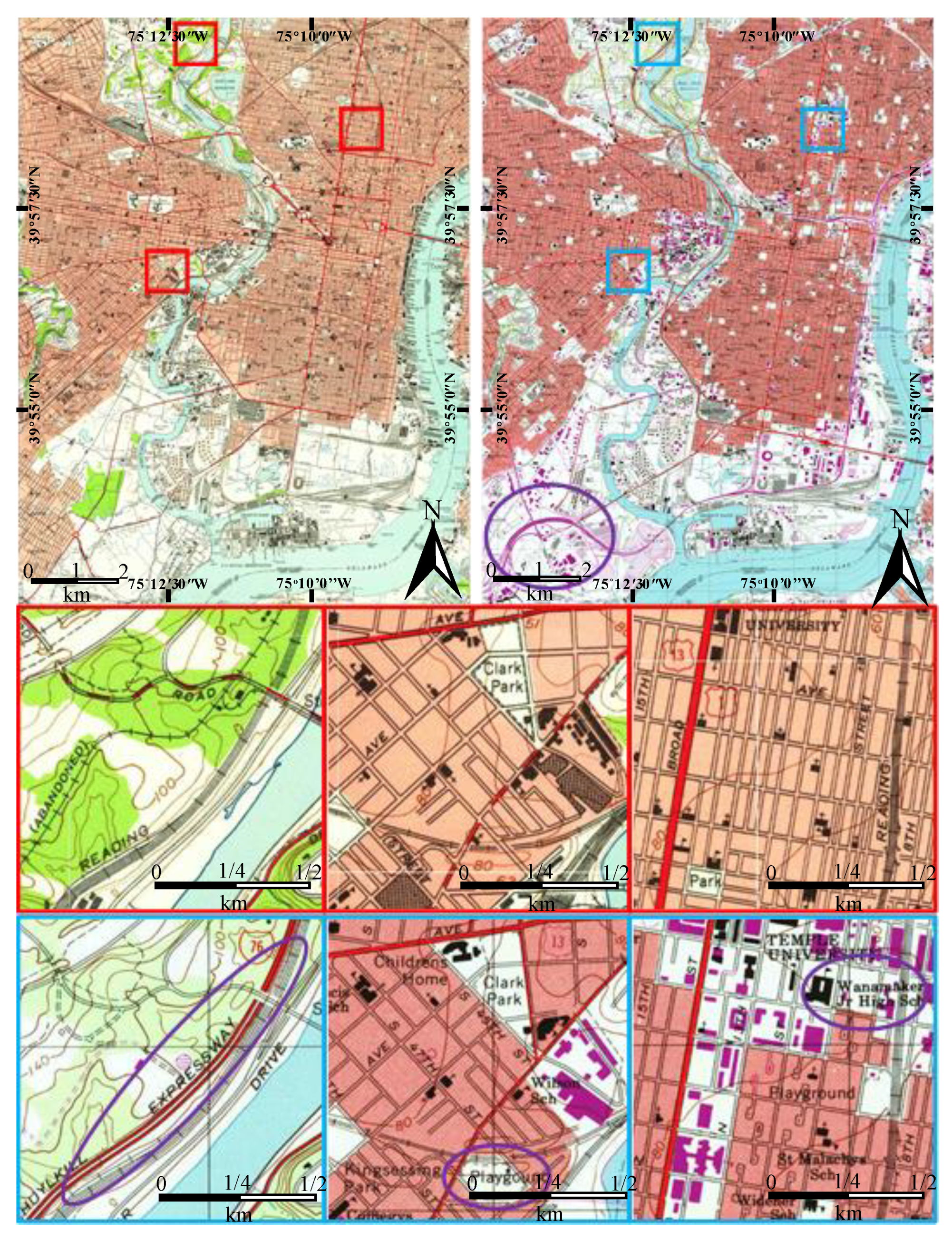
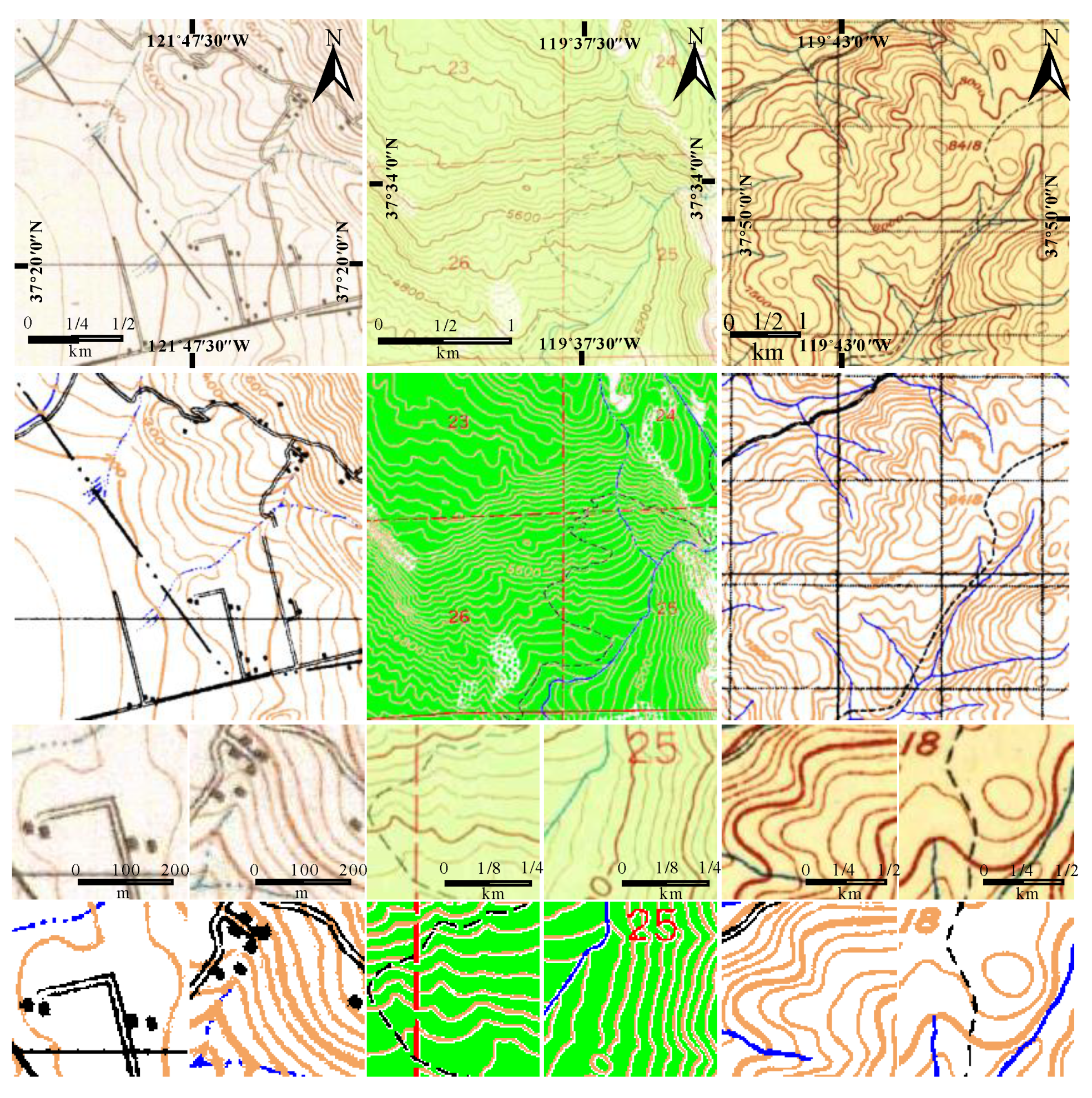
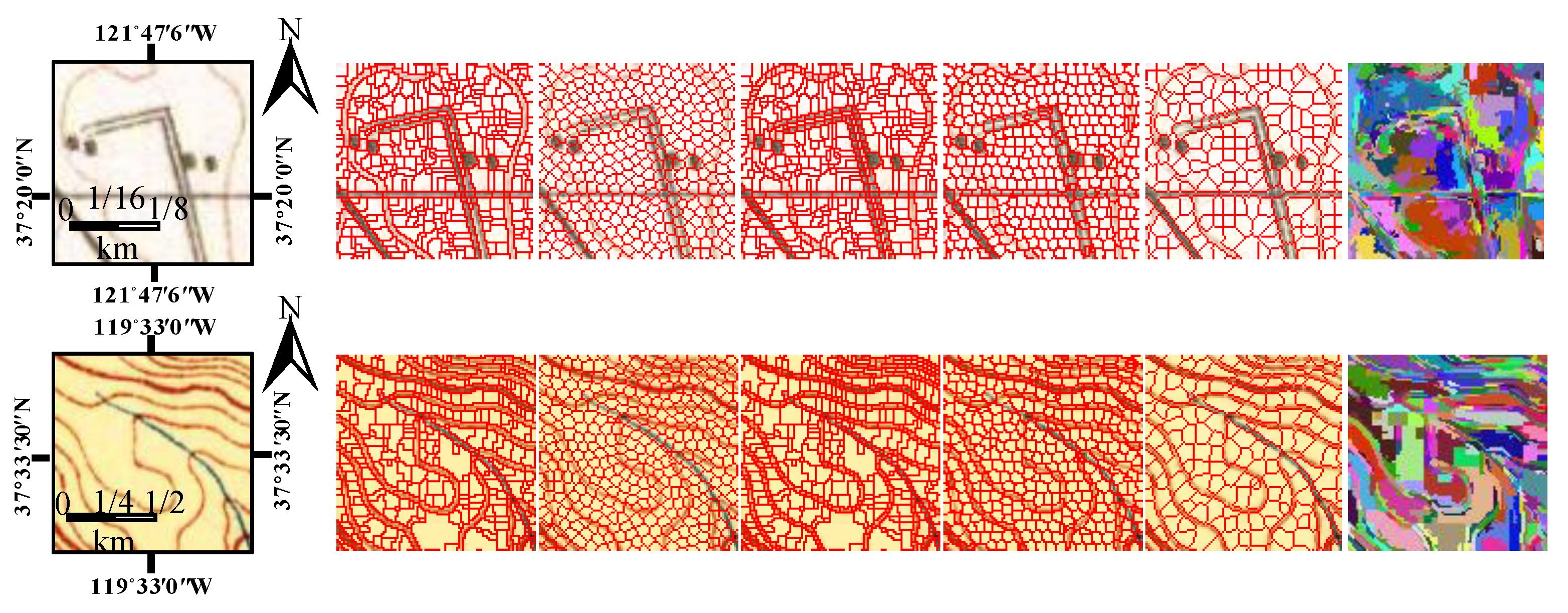
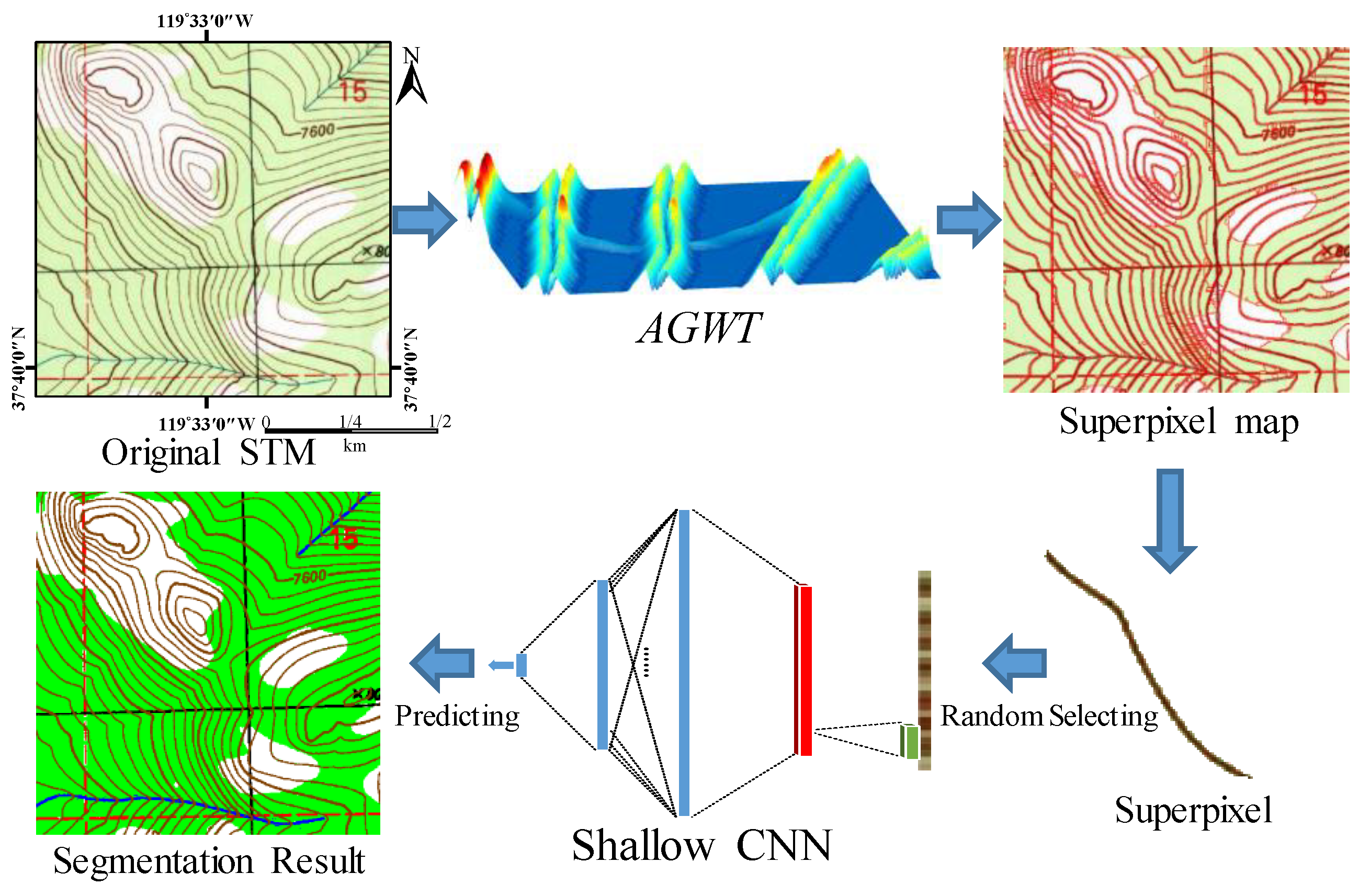
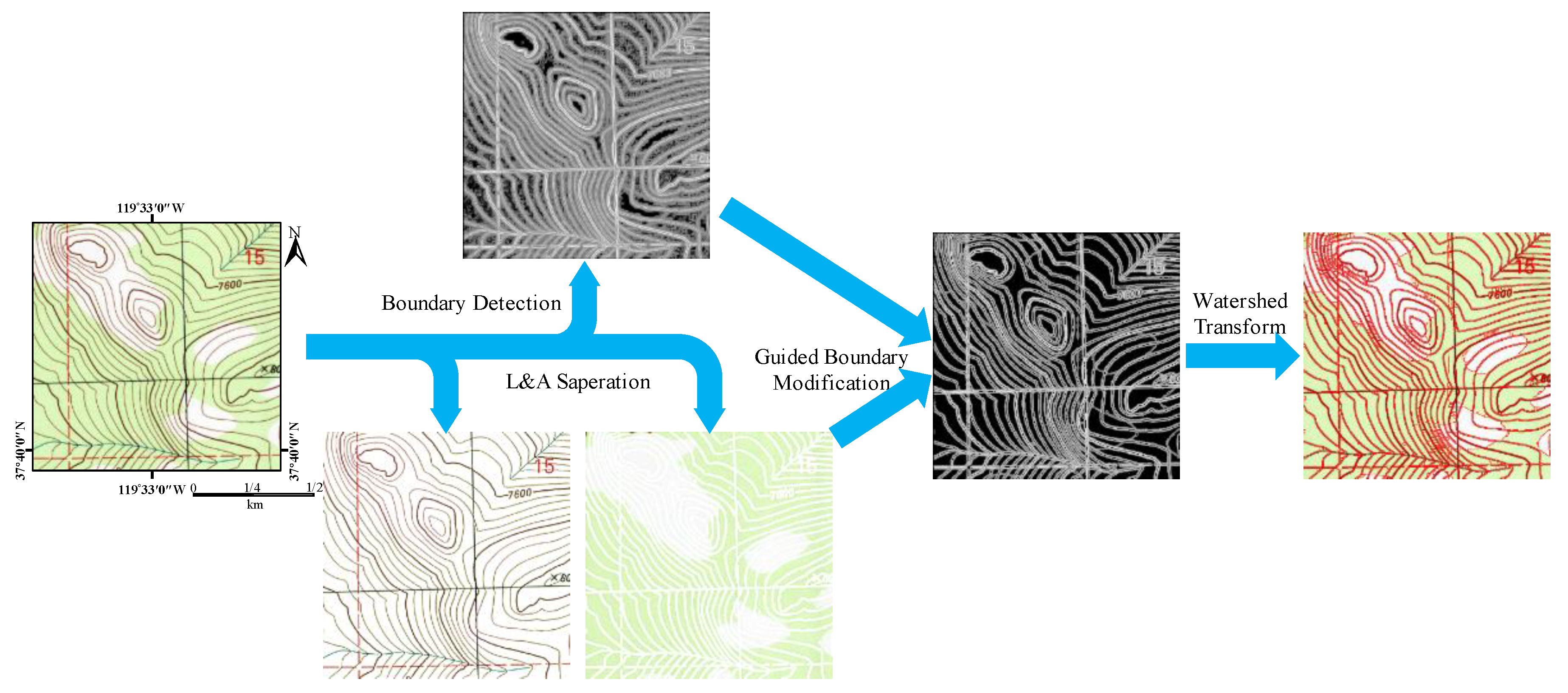
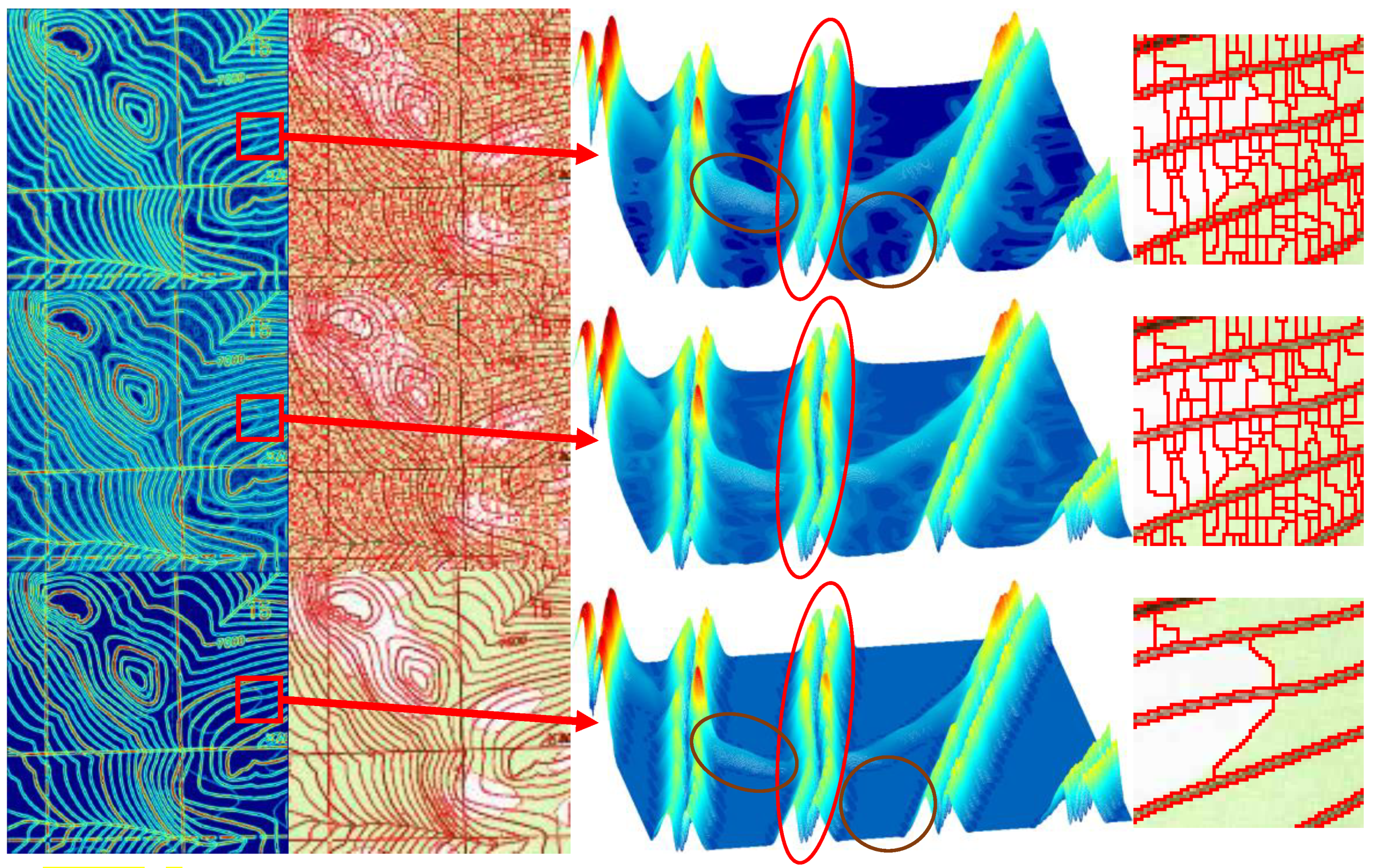
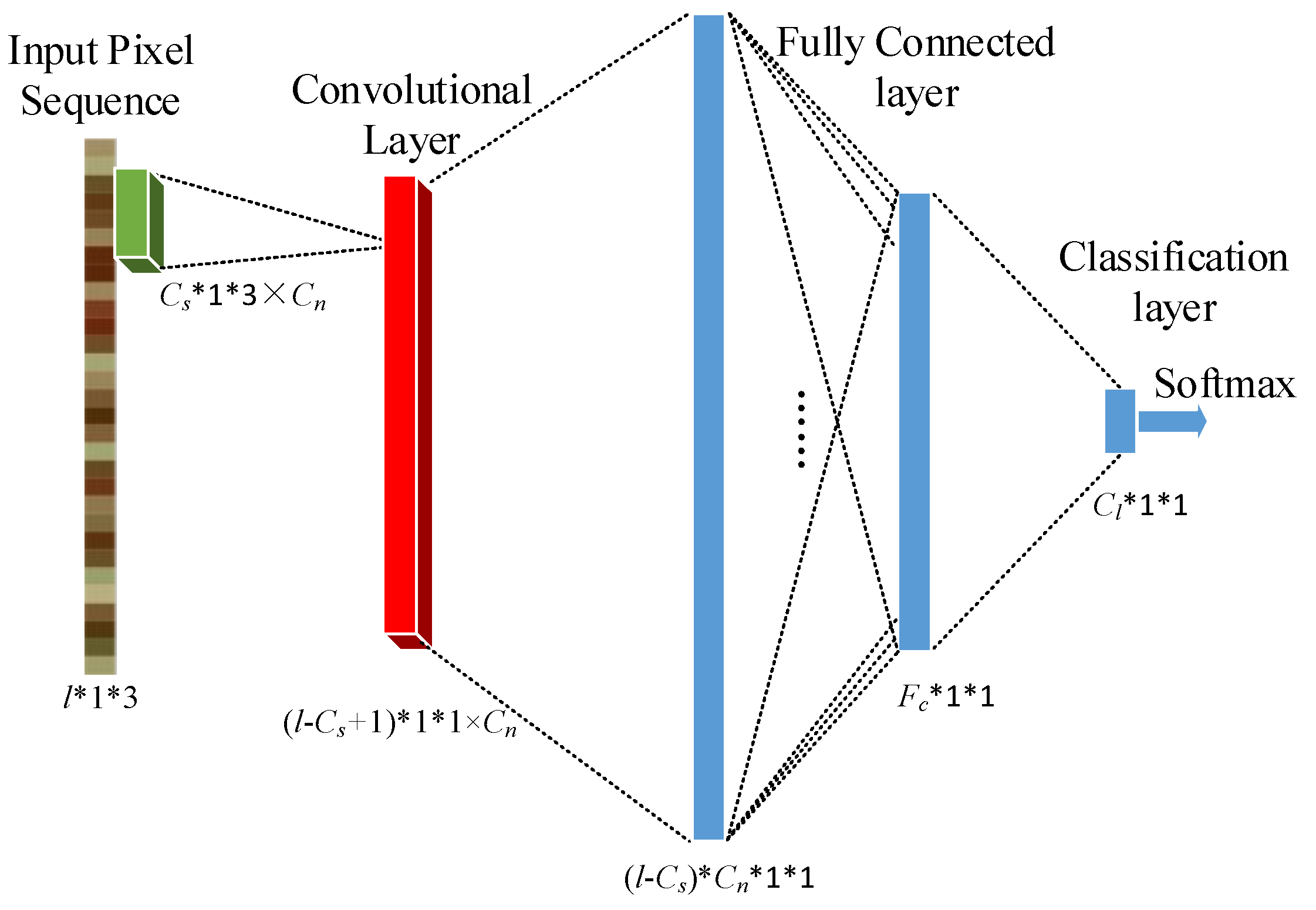
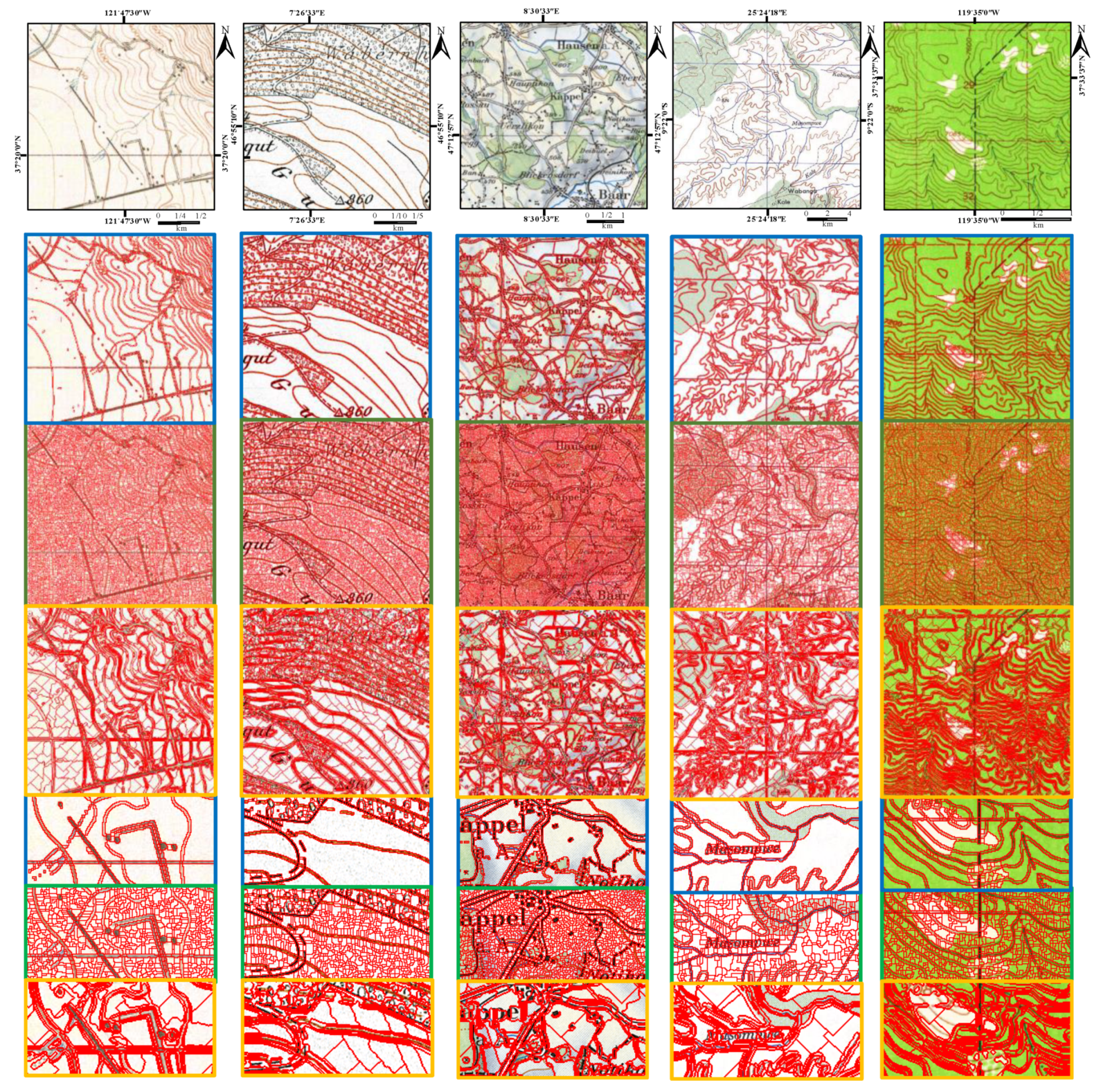
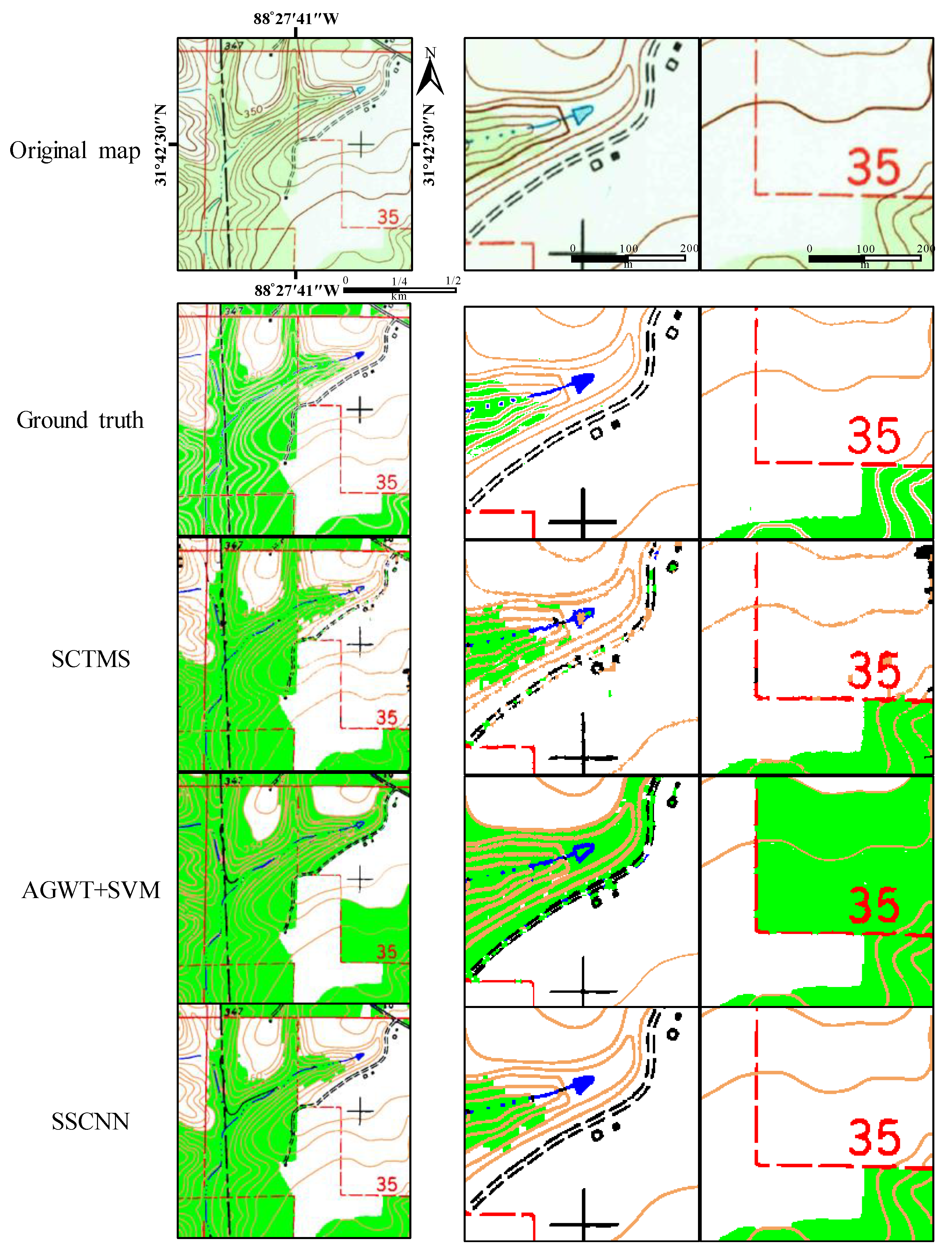
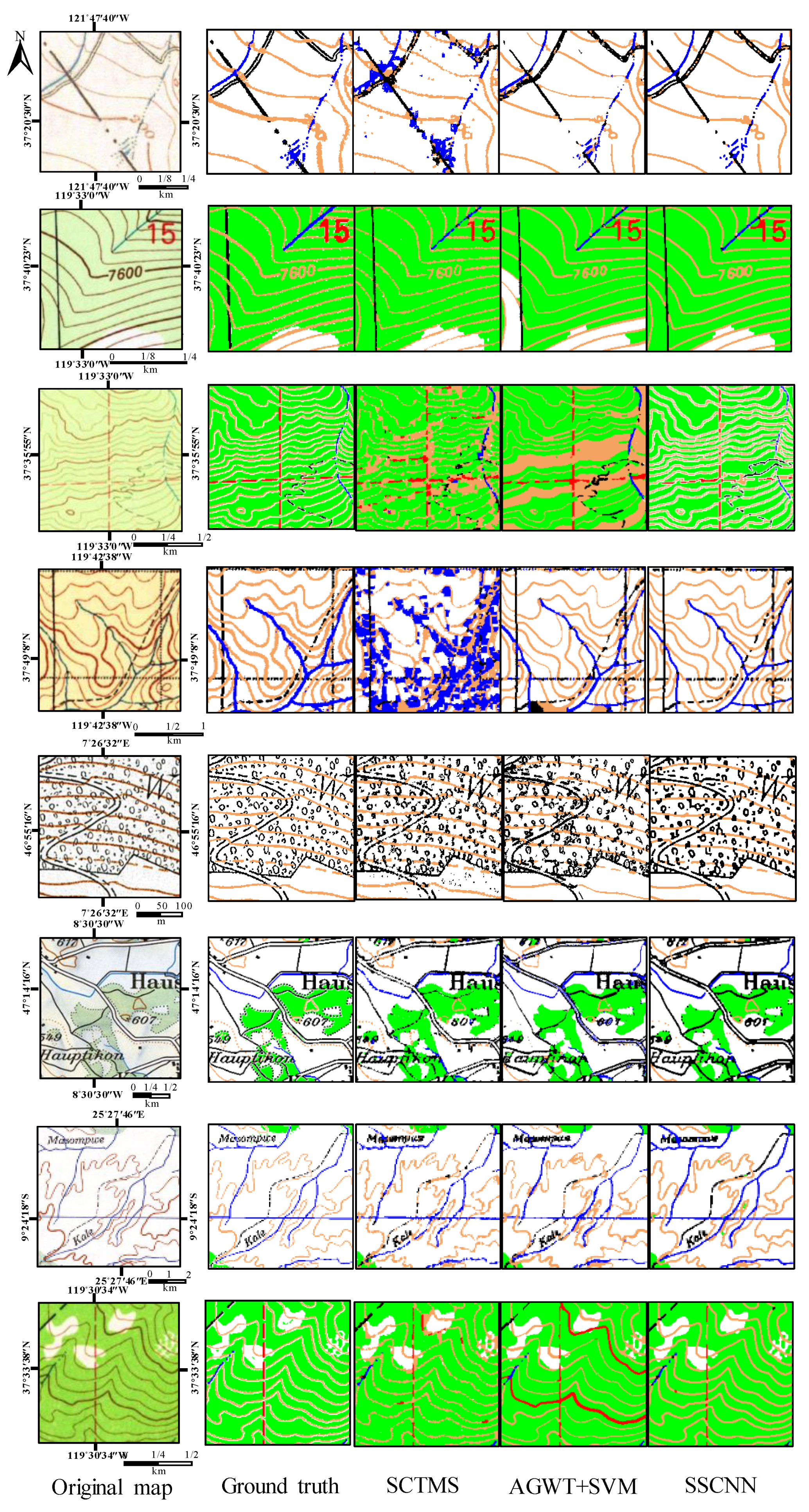
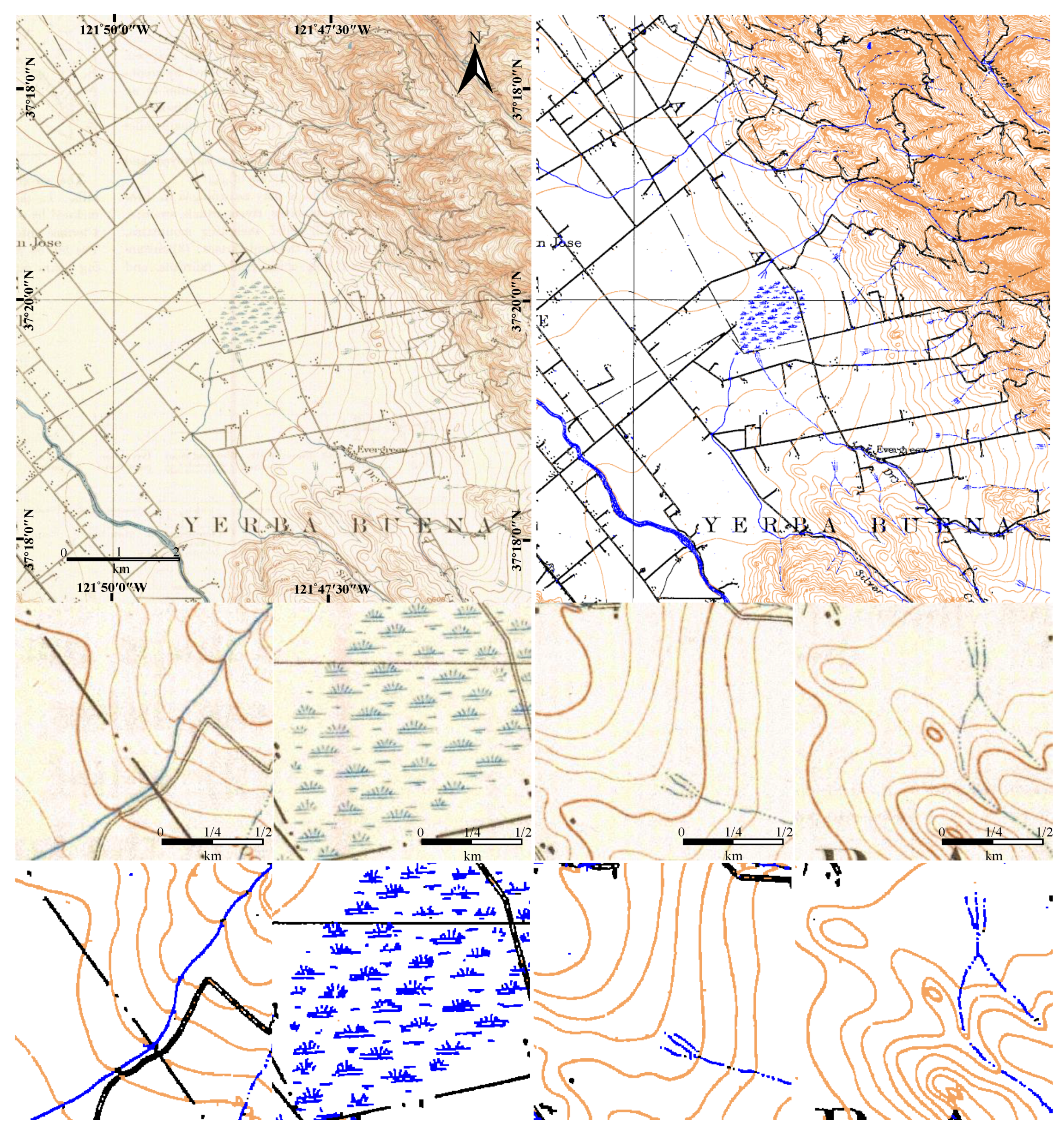

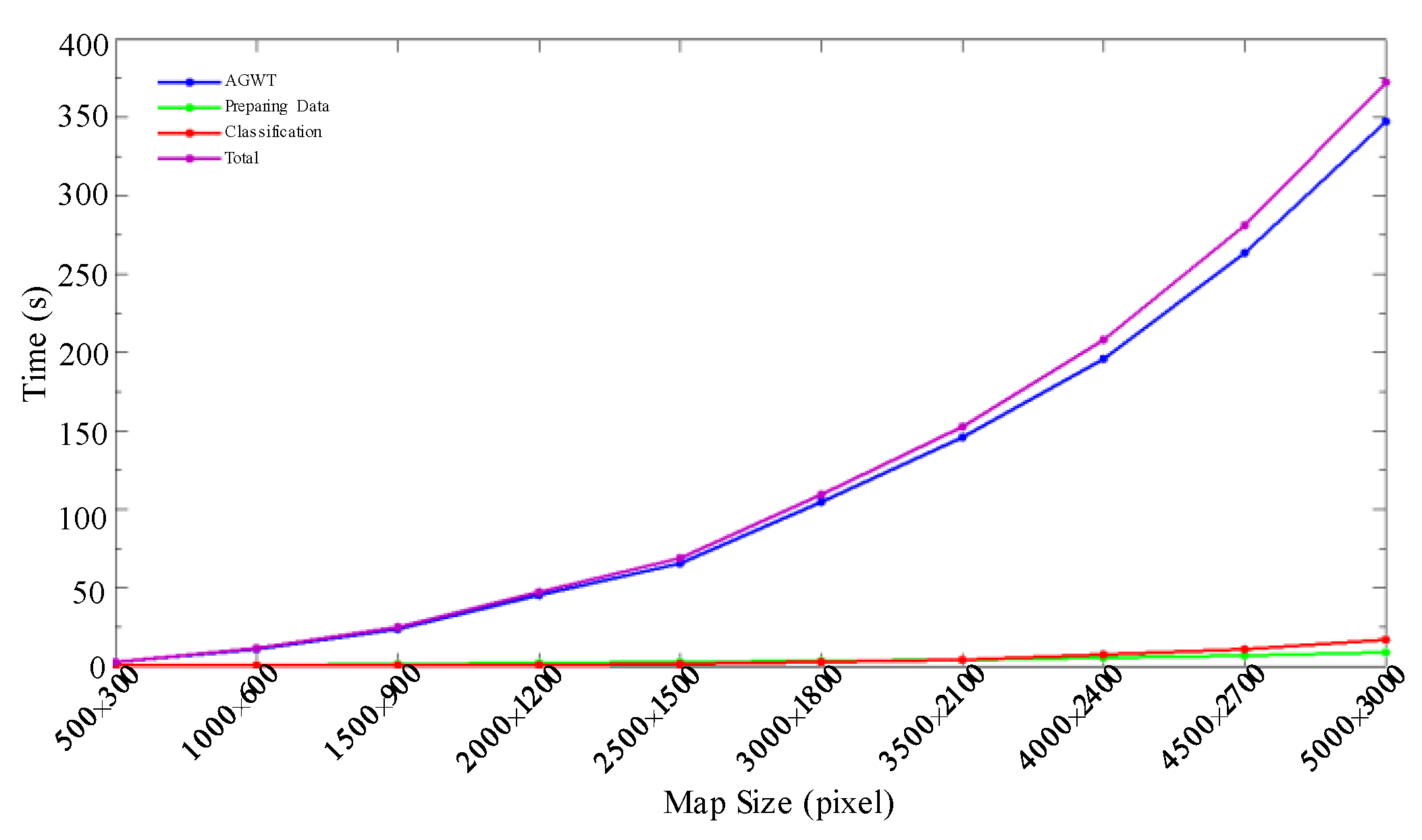
| BR | BP | UE | |
|---|---|---|---|
| Unsupervised CNN [33] | 0.9019 (0.0784) | 0.6039 (0.1001) | 0.0967 (0.0444) |
| GSM-TM | 0.9816 (0.0121) | 0.5482 (0.1001) | 0.0644 (0.0261) |
| AGWT | 0.9590 (0.0318) | 0.9454 (0.0270) | 0.0598 (0.0311) |
| No. | STM Size | GSM-TM | AGWT | Unsupervised CNN [33] |
|---|---|---|---|---|
| 1 | 512 × 512 | 9477 | 1554 | 1923 |
| 2 | 512 × 512 | 6514 | 1367 | 2514 |
| 3 | 512 × 512 | 5716 | 2607 | 3063 |
| 4 | 512 × 512 | 6978 | 3331 | 3462 |
| 5 | 512 × 512 | 12,278 | 4324 | 2138 |
| 6 | 512 × 512 | 11,453 | 5280 | 2121 |
| 7 | 512 × 512 | 7649 | 2486 | 2808 |
| 8 | 536 × 730 | 8486 | 1059 | 972 |
| 9 | 512 × 512 | 6566 | 1841 | 1835 |
| 10 | 467 × 510 | 6190 | 1427 | 1768 |
| 11 | 512 × 512 | 10,693 | 1434 | 1478 |
| 12 | 393 × 460 | 7089 | 2988 | 2222 |
| 13 | 700 × 700 | 19,708 | 6143 | 1416 |
| 14 | 536 × 730 | 17,134 | 2653 | 1445 |
| 15 | 563 × 840 | 21,396 | 5028 | 2253 |
| Precision | Recall | F1 Score | |
|---|---|---|---|
| SCTMS | 0.6609 (0.22) | 0.7283 (0.14) | 0.6617 (0.16) |
| AGWT+SVM | 0.6814 (0.20) | 0.7095 (0.15) | 0.6670 (0.14) |
| SSCNN | 0.7340 (0.17) | 0.7580 (0.14) | 0.7251 (0.11) |
Publisher’s Note: MDPI stays neutral with regard to jurisdictional claims in published maps and institutional affiliations. |
© 2020 by the authors. Licensee MDPI, Basel, Switzerland. This article is an open access article distributed under the terms and conditions of the Creative Commons Attribution (CC BY) license (http://creativecommons.org/licenses/by/4.0/).
Share and Cite
Liu, T.; Miao, Q.; Xu, P.; Zhang, S. Superpixel-Based Shallow Convolutional Neural Network (SSCNN) for Scanned Topographic Map Segmentation. Remote Sens. 2020, 12, 3421. https://doi.org/10.3390/rs12203421
Liu T, Miao Q, Xu P, Zhang S. Superpixel-Based Shallow Convolutional Neural Network (SSCNN) for Scanned Topographic Map Segmentation. Remote Sensing. 2020; 12(20):3421. https://doi.org/10.3390/rs12203421
Chicago/Turabian StyleLiu, Tiange, Qiguang Miao, Pengfei Xu, and Shihui Zhang. 2020. "Superpixel-Based Shallow Convolutional Neural Network (SSCNN) for Scanned Topographic Map Segmentation" Remote Sensing 12, no. 20: 3421. https://doi.org/10.3390/rs12203421
APA StyleLiu, T., Miao, Q., Xu, P., & Zhang, S. (2020). Superpixel-Based Shallow Convolutional Neural Network (SSCNN) for Scanned Topographic Map Segmentation. Remote Sensing, 12(20), 3421. https://doi.org/10.3390/rs12203421








